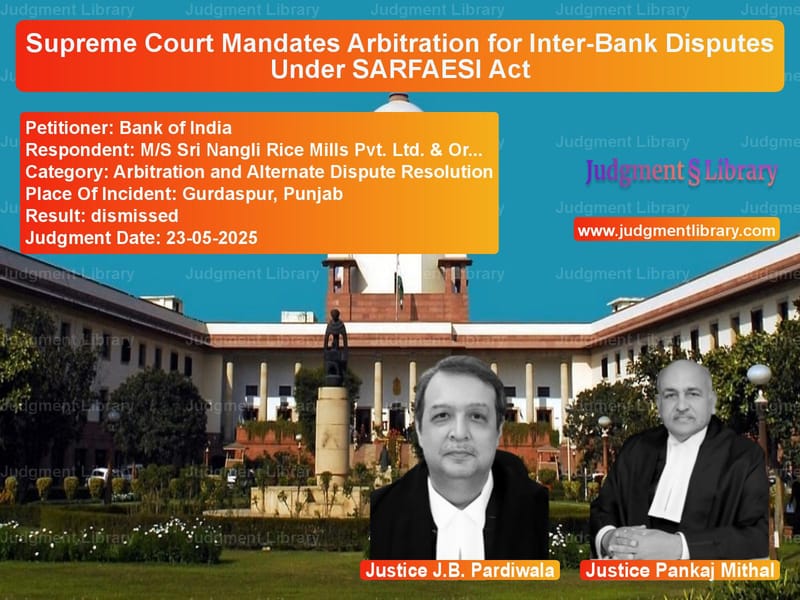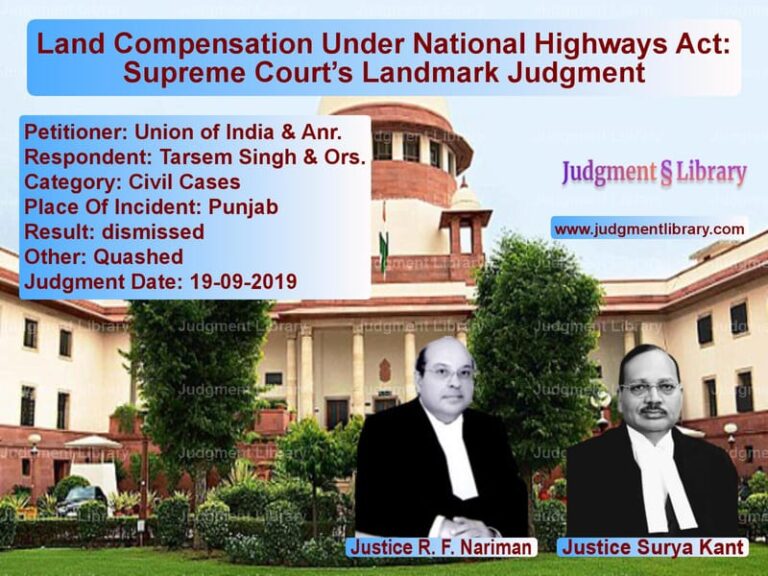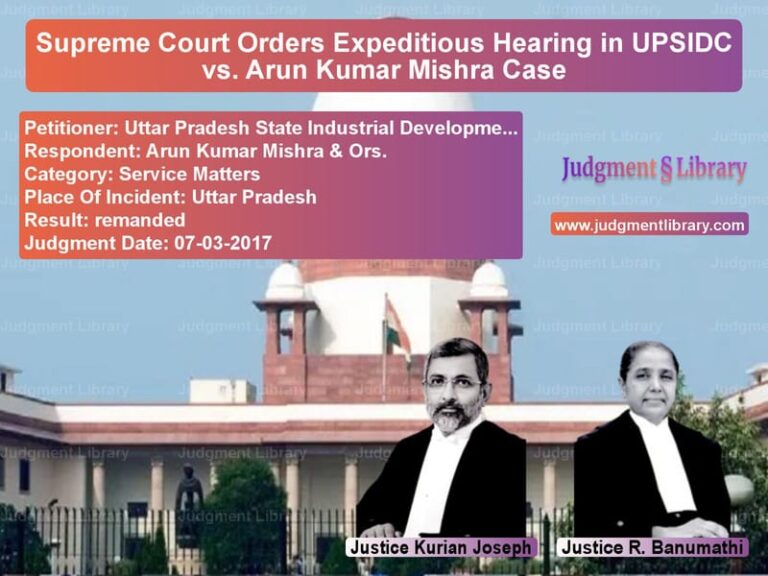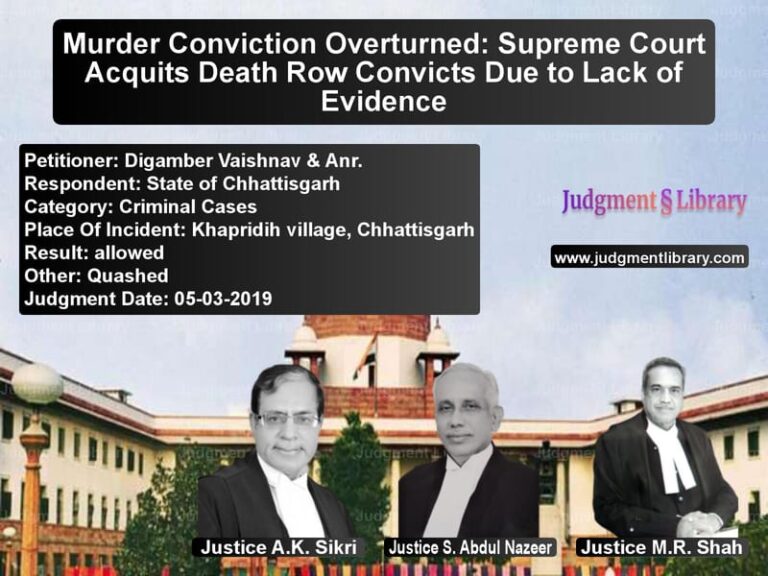Supreme Court Mandates Arbitration for Inter-Bank Disputes Under SARFAESI Act
In a landmark judgment that clarifies the resolution mechanism for disputes between financial institutions, the Supreme Court of India has delivered a comprehensive ruling on the interpretation and application of Section 11 of the Securitisation and Reconstruction of Financial Assets and Enforcement of Security Interest Act, 2002 (SARFAESI Act). The case between Bank of India and Punjab National Bank, concerning competing claims over the same secured assets of a common borrower, has settled several important legal questions regarding how banks must resolve their inter-se disputes.
The dispute originated when Bank of India discovered that stocks of paddy and rice it had hypothecated as security for loans to M/s Sri Nangli Rice Mills Pvt. Ltd. were also pledged to Punjab National Bank. Both banks claimed priority over the same security, leading to a legal battle that traveled through the Debt Recovery Tribunal, the Debt Recovery Appellate Tribunal, the Punjab and Haryana High Court, and finally to the Supreme Court.
The core issue revolved around whether such disputes between two banks should be adjudicated by the DRT under Section 17 of the SARFAESI Act or referred to arbitration under Section 11. The Supreme Court’s detailed analysis has provided much-needed clarity on this important aspect of banking law.
The Factual Background
The story begins in 2003 when M/s Sri Nangli Rice Mills Pvt. Ltd. availed credit facilities from Bank of India by hypothecating stocks of paddy and other assets. A formal Credit Facility Agreement was executed on September 23, 2006, containing crucial clauses that prohibited the borrower from creating any additional charges or encumbrances on the secured assets without the bank’s prior written consent.
Specifically, clauses 4.6, 4.15 to 4.17, and 4.23 of the agreement explicitly stated that the borrower shall not borrow from other banks or financiers without consent, shall keep the securities free from encumbrances, shall not remove the security without consent, and shall not create third-party rights on the security.
Despite these clear restrictions, while the loan from Bank of India remained outstanding, the borrower simultaneously availed another credit facility from Punjab National Bank in 2013. An Agreement of Advance/Pledge Agreement dated December 6, 2013 was executed, whereby warehouse receipts of certain goods including stocks of paddy and rice were pledged in favor of PNB.
The conflict came to light in 2015 when Bank of India, after classifying the borrower’s account as a Non-Performing Asset (NPA), conducted an inspection and discovered pledge tags of Punjab National Bank affixed on the security that Bank of India believed was exclusively hypothecated to them.
This discovery triggered a series of correspondence between the two banks, each asserting their rights over the secured assets. Bank of India claimed its hypothecation charge was prior in time and therefore superior, while Punjab National Bank maintained that its pledge was legitimate and the stocks were duly tagged and earmarked throughout.
The Legal Journey
The legal proceedings began with Bank of India filing a suit for permanent injunction to restrain PNB from selling the disputed stocks. Simultaneously, the bank initiated proceedings under the SARFAESI Act, including an application under Section 14 for taking physical possession of the secured assets.
The District Magistrate, in an order dated October 12, 2016, allowed Bank of India to take physical possession of the secured assets except the stocks pledged with PNB. This led to a securitization application before the DRT, which initially ruled in favor of Bank of India, holding that its hypothecation charge was prior in time and would take precedence over any subsequent charge.
However, the DRAT remanded the matter back to DRT, observing that the tribunal had failed to consider preliminary objections regarding the maintainability of the application under Section 17 against another bank. On remand, the DRT held that it had no jurisdiction to adjudicate disputes between two banks and directed the parties to resolve their dispute through arbitration under Section 11 of the SARFAESI Act.
This decision was upheld by the Punjab and Haryana High Court, prompting Bank of India to approach the Supreme Court.
Arguments Before the Supreme Court
Senior Counsel Mr. Dhruv Mehta, appearing for Bank of India, made several key submissions. He argued that Section 11 of the SARFAESI Act is inapplicable to the present case as there is no legitimate dispute between the appellant and respondent bank in view of Section 31(b) of the Act, which explicitly excludes ‘pledge’ from the scope of the SARFAESI Act.
Mr. Mehta contended that Bank of India holds a prior charge as the security was created through credit facilities sanctioned in 2003 and duly registered through the Credit Facility Agreement of 2006, while PNB had purportedly created a charge only in 2013. He further argued that the stocks pledged in favor of PNB were null and void in view of the terms of the Credit Facility Agreement that prohibited the creation of additional charges.
The senior counsel also challenged the High Court’s reliance on the Oriental Bank of Commerce case, arguing that it was contrary to the earlier decision in Federal Bank Ltd. case which held that Section 11 would only apply when there is an arbitration agreement subsisting between the parties. He emphasized that no such arbitration agreement existed between the banks in this case.
Mr. Mehta’s final submission was that Section 11 is confined to Chapter II of the SARFAESI Act dealing with securitization and reconstruction, and has no application to enforcement of security interest provided in Chapter III.
On the other side, Ms. Ekta Choudhary, appearing for Punjab National Bank, also relied on Section 31(b) but to contend that since the provision stipulates that the SARFAESI Act shall not apply to pledge of movable goods, Section 11 would consequently be inapplicable to such cases.
In the alternative, she submitted that if Section 11 is found applicable, then no error could be attributed to the High Court’s impugned order. She argued that the expression “any dispute relating to securitisation or reconstruction or non-payment of any amount due including interest” is of wide import and would include disputes pertaining to recovery of outstanding loan dues and enforcement of security interest.
Ms. Choudhary also invited the Court’s attention to the Administrative Mechanism for Resolution of CPSEs Disputes (AMRCD) Memorandum, contending that since the dispute is between two public sector banks, it ought to be resolved under this framework.
The Supreme Court’s Analysis
The Supreme Court, in its detailed judgment, addressed four key issues for determination regarding the scope and application of Section 11 of the SARFAESI Act.
The Court began by examining the legislative history and scheme of the SARFAESI Act, noting that it was enacted to empower banks and financial institutions to take possession of securities and sell them without court intervention, addressing the poor rate of loan recovery and failure of existing legislation.
The Court observed: “The entire scheme of the SARFAESI Act is premised on the liability of the borrower being crystallized by virtue of its classification as a non-performing asset by the secured creditor.”
On the scope of Section 11, the Court held that it is limited by twin conditions: first, the dispute must be between any bank, financial institution, asset reconstruction company, or qualified buyer; and second, the dispute must relate to securitization, reconstruction, or non-payment of any amount due including interest.
The Court explained the object behind Section 11: “The object underlying Section 11 of the SARFAESI Act insofar as it mandates arbitration or conciliation as the only mechanism for resolution of disputes between a bank, financial institution, ARC etc., and ousts the jurisdiction of the DRTs under Section 17 for adjudicating such disputes is to ensure that ancillary or collateral disputes that may arise between competing secured creditors do not hinder the larger purpose of the SARFAESI Act of facilitating recoveries of dues from the borrowers expeditiously.”
The Court further elaborated: “In the absence of any such mandate as enshrined in Section 11 of the SARFAESI Act, every conflict between secured creditors over a security interest would ultimately just prolong the recovery proceedings against the borrower and thwart any possibility of a meaningful recovery of bad debts.”
Addressing the meaning of the expression “non-payment of any amount due including interest,” the Court held that it has wide import and includes various scenarios of disputes connected to unpaid amounts, including those arising due to third-party defaults such as indirect defaults of borrowers.
The Court stated: “The dispute stems from the borrower’s failure to discharge their debt obligations, including the amounts they were bound to pay to the banks. This non-payment gives rise to a conflict between the creditors regarding the hierarchy of their respective charges over the borrower’s assets.”
On the crucial question of whether a written arbitration agreement is required under Section 11, the Court held that there is no such requirement. The Court emphasized that Section 11 creates a legal fiction whereby it is presumed that the parties have consented in writing to arbitration.
The Court explained: “The legislature in its wisdom has not only prescribed and mandated the resolution of disputes covered under the said provision by way of arbitration, but by consciously using the aforesaid expression, has gone one step ahead by providing a deeming fiction whereby, an arbitration agreement is presumed to exists between the parties falling under the said provision for the resolution of any ‘dispute’ between them that is specified thereunder.”
The Court specifically overruled the contrary view taken in Federal Bank and Standard Chartered Bank cases, while approving the position in Oriental Bank of Commerce and D. Dhanamjaya Rao cases.
Regarding the mandatory nature of Section 11, the Court held that the use of the word “shall” indicates that the provision is mandatory and not directory. The Court stated: “The usage of ‘shall’ in the provision mandates the parties to adhere to the mentioned mechanism and restricts them from approaching any other forums. The parties cannot bypass or subvert it by seeking recourse elsewhere. If arbitration or conciliation is the prescribed route, then that prescribed route shall be followed.”
The Court also rejected the respondent’s contention regarding the applicability of the AMRCD Memorandum, holding that the dispute does not relate to the interpretation and application of provisions of commercial contracts between the banks, but arises from separate agreements with a common borrower.
The Final Conclusion
The Supreme Court summarized its conclusions in six key points. First, Section 11 deals with resolution of disputes relating to securitization, reconstruction or non-payment of any amount due between specified financial entities.
Second, the twin conditions of the dispute being between the enumerated parties and relating to the specified subjects must be satisfied for Section 11 to apply.
Third, the expression “non-payment of any amount due, including interest” has wide import and includes disputes connected to unpaid amounts arising due to third-party defaults.
Fourth, when the jural relationship between two financial entities is that of lender and borrower, Section 11 has no application. The Court clarified: “The use of the phrase ‘any person’ in the definition of ‘borrower’ in Section 2(f) of the SARFAESI Act, makes it abundantly clear that even a bank, financial institution or asset reconstruction company or qualified buyer can be considered a borrower, if they receive financial assistance from a bank or financial institution etc by providing or creating a security interest.”
Fifth, there is no need for an explicit written arbitration agreement as Section 11 creates a legal fiction regarding the existence of such agreement.
Sixth, Section 11 is mandatory in nature and the parties cannot bypass it by seeking recourse elsewhere.
The Court ultimately dismissed Bank of India’s appeal, upholding the High Court’s direction for the banks to resolve their dispute through arbitration under Section 11 of the SARFAESI Act.
This judgment significantly clarifies the dispute resolution mechanism for inter-bank conflicts under the SARFAESI Act, emphasizing the legislature’s intent to ensure that disputes between secured creditors do not hinder the expeditious recovery of dues from borrowers. By mandating arbitration for such disputes, the Court has reinforced the specialized nature of debt recovery tribunals while providing a streamlined mechanism for resolving conflicts between financial institutions.
Petitioner Name: Bank of India.Respondent Name: M/S Sri Nangli Rice Mills Pvt. Ltd. & Ors..Judgment By: Justice J.B. Pardiwala, Justice Pankaj Mithal.Place Of Incident: Gurdaspur, Punjab.Judgment Date: 23-05-2025.Result: dismissed.
Don’t miss out on the full details! Download the complete judgment in PDF format below and gain valuable insights instantly!
Download Judgment: bank-of-india-vs-ms-sri-nangli-rice-supreme-court-of-india-judgment-dated-23-05-2025.pdf
Directly Download Judgment: Directly download this Judgment
See all petitions in Arbitration Awards
See all petitions in Commercial Arbitration
See all petitions in Dispute Resolution Mechanisms
See all petitions in Debt Recovery
See all petitions in Contract Disputes
See all petitions in Judgment by J.B. Pardiwala
See all petitions in Judgment by Pankaj Mithal
See all petitions in dismissed
See all petitions in supreme court of India judgments May 2025
See all petitions in 2025 judgments
See all posts in Arbitration and Alternate Dispute Resolution Category
See all allowed petitions in Arbitration and Alternate Dispute Resolution Category
See all Dismissed petitions in Arbitration and Alternate Dispute Resolution Category
See all partially allowed petitions in Arbitration and Alternate Dispute Resolution Category







